A while ago, Mitsubishi was a synonym for a successful road version of a rally car. Then, they appeared to be a little bit lost for some time. Like they didn’t know, what to do. Now they know, and have a new mega sales hit, called Mitsubishi Outlander PHEV.
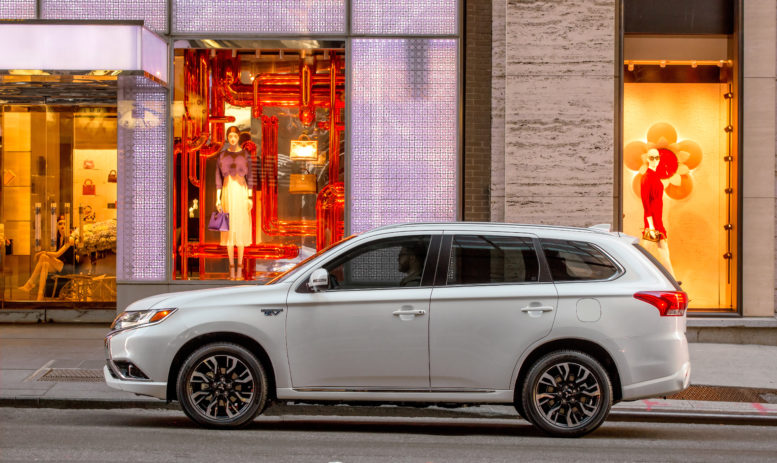
Mitsubishi Outlander PHEV has a 52 kilometers (32 miles) of potential EV range.
2016 Mitsubishi Outlander PHEV highlights
While conventionally powered Outlander is not very successful in the fight with the competition, its plug-in hybrid version PHEV is a hit. No wonder: it is very good, especially by the plug-in hybrid criteria.
We praise:
- drive train,
- fuel consumption,
- usability.
We criticize:
- bad user interface,
- short longitudinal movement of the driver’s seat.
Success on basis of good looks and lack of competition
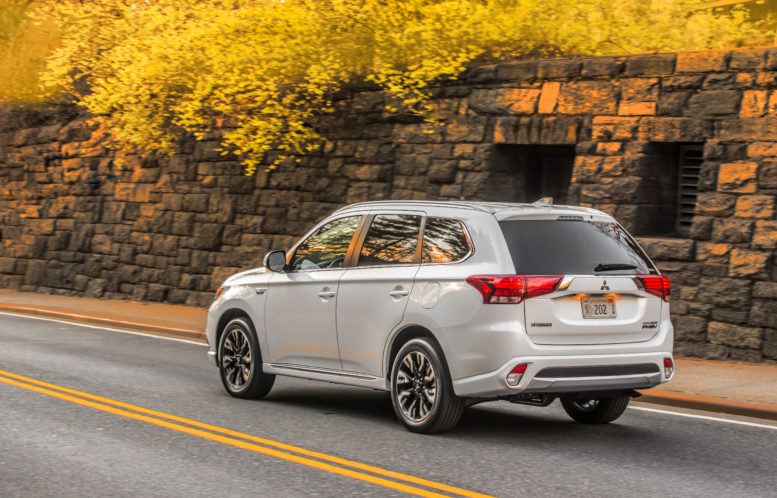
Looks good, lacks competition, with acceptable price: sales success guaranteed.
Why is the crossover Mitsubishi Outlander PHEV plug-in hybrid so successful? There are many reasons, but one of them is for sure the shape of the bodywork. Competition, so to speak, is not sufficient, and the price is more than favorable.
In fact, Mitsubishi abandoned the hunt for record distances the car is capable of driving only on electricity. Officially, the Mitsubishi Outlander PHEV can make around 50 kilometers. Board computer never showed us more than 41 kilometers of potential reach. And the real life number is somewhere between 30 and 35 kilometers. But this may be sufficient, particularly if the Outlander PHEV can also be recharged while you are at work.
Theoretically, Mitsubishi Outlander PHEV’s fuel consumption equals zero
If the driver makes an effort and uses Mitsubishi Outlander PHEV as such a car should be used, the fuel consumption is mostly zero. In our review, there were some days when we actually did not spend a single drop of gasoline. And the reason for an average test consumption of around 5 liters of fuel per 100 kilometers, are some not so short continuous highway routes. In this case, the gasoline engine jumps in.
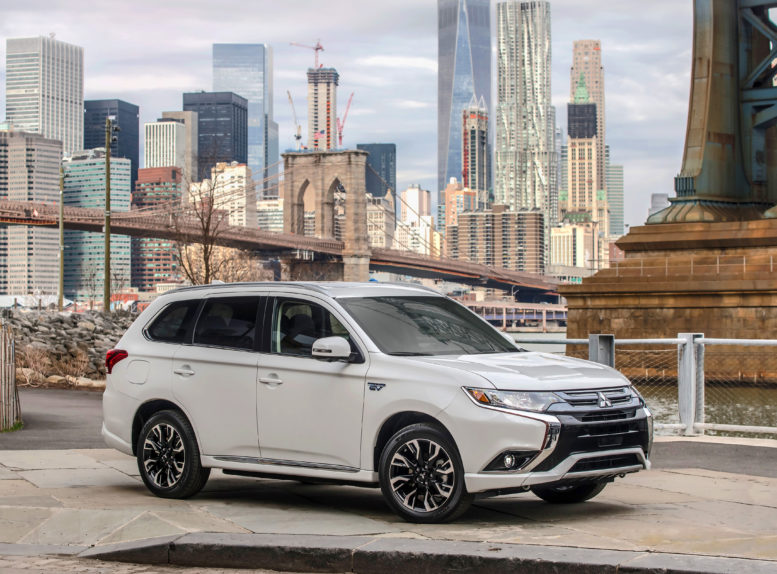
With careful ECO driving, the Mitsubishi Outlander PHEV can reach infinite mpg.
And because the two-liter petrol engine with 121 HP, that must run a 1,800 kilograms heavy Mitsubishi Outlander PHEV, is not and cannot be the most economical one. Therefore, the average fuel consumption rises. But still, our average fuel consumption on a norm lap was 4.8 liters. Of course, we started with a full, and finished with an empty battery. The average electricity consumption is 16.6 kilowatt hours per 100 kilometers. Excellent, and better than a comparable vehicle with diesel engine, for about 2 liters less per 100 kilometers. And do not forget, Mitsubishi Outlander PHEV has nevertheless a total system power of 203 HP (a combination of a petrol engine and two 82 HP electric motors, for each pair of wheels), automatic transmission and four-wheel drive.
Serial hybrid or parallel hybrid
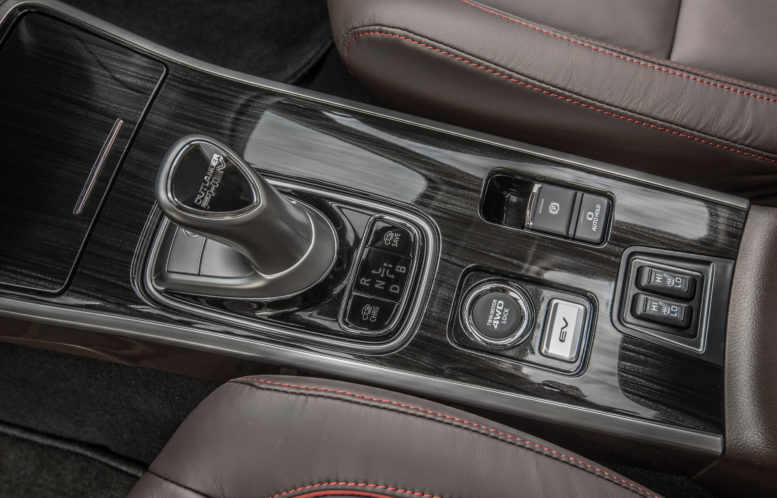
Automatic transmission, all wheel drive.
In addition to driving on electricity, Outlander PHEV 2016 in other cases works as a hybrid. What’s more, it can work as a serial or parallel hybrid. In the first mode, the petrol engine operates solely as a generator, charging the batteries. This hybrid mode is used primarily at lower speeds and when the requirements for power are lower (and of course the battery is empty).
In parallel hybrid mode (at higher speeds and greater driver requirements), the engine directly connects to the front wheels, and joins both electric motors. While typically only the front electric engine runs, the rear one engages, when the power demand is large enough or when the four-wheel drive system S-AWC decides that driving conditions are too demanding for only front wheel drive and that it is necessary to run the rear wheels also. The driver can also intervene by pressing the ‘lock’ button and permanently enables all-wheel drive.
Beside the fully automatic mode, Mitsubishi Outlander PHEV also includes the driving mode, which saves the battery power (when in this mode, the hybrid system retains the battery charge at the same level) and the driving mode for charging the battery. Both are useful when the driver wants to keep enough electricity for pure electric driving for the end of the trip.
Pure EV mode not available, but still possible
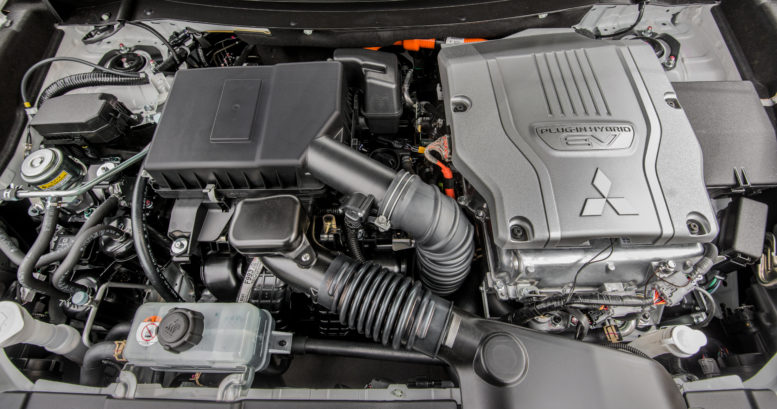
Mitsubishi Outlander PHEV: 2-liter petrol engine supports two electric motors. Total system power: 203 HP.
Interestingly, the 2016 Outlander PHEV does not have an EV mode, which would force an all-electric driving. If the driver hardly presses the accelerator, the petrol engine starts. But such events are rare, since the two electric motors together are powerful enough.
Of course, the battery is also charged with the help of the regeneration. The level of regeneration is set by the driver with the steering wheel paddles. The same paddles, which are responsible for manually shifting the automatic transmission in the conventional Outlander. But unfortunately, you have to apply these settings each time you start the car. Because Mitsubishi Outlander PHEV can not remember them. By default, it always starts with the weakest recovery, which may be (for those who want stronger regeneration) very annoying after a few days.
Mitsubishi Outlander PHEV user interface needs improvement
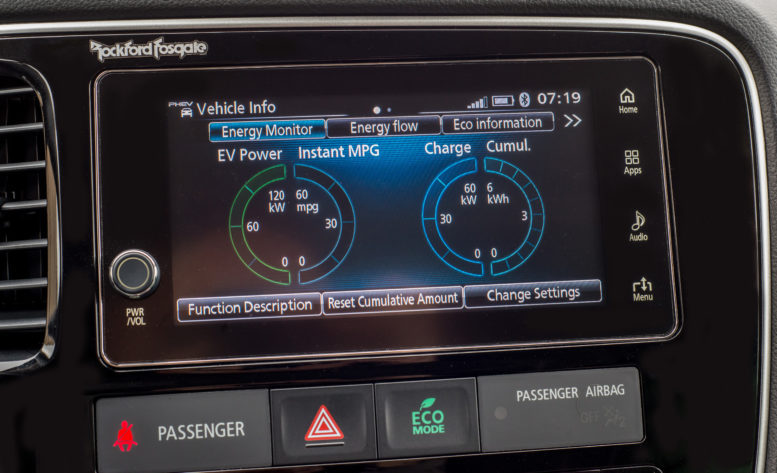
Touch-sensitive LCD screen in Outlander PHEV: too much clicking involved.
The same applies to some other settings as well as central, touch-sensitive LCD screen. In general, there is too much clicking involved. For example, if you want to see how Eco you are driving or what the drive system is doing, the system does not remember what you watched last. Mitsubishi has a lot to learn about the user interface usability. Above all, there is no option that Outlander’s powertrain remains in Eco mode. It is necessary to manually apply this setting after each start of the engine.
Charging times: 5 hours at home, 30 minutes at fast charging station
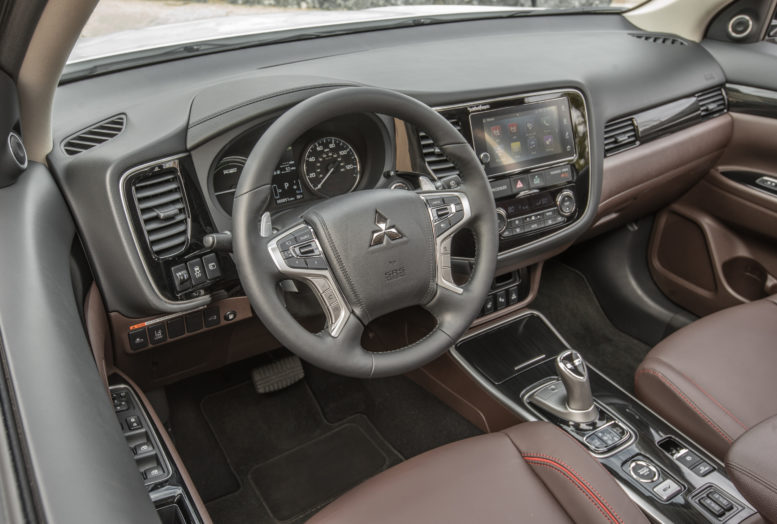
The interior prides itself with sufficient spaciousness (including rear) and comfort.
The battery can be charged via an ordinary house connectors. In this case, the charging process takes up to six hours. Charging through wallbox or from the charging station takes about four hours. The fastest option is a fast charging stations with CHAdeMO standard. Here the battery fills up to 80 percent in half an hour and to 100 percent in less than an hour. Fast enough to be able to drive mostly on electrical power and save the petrol. Due to small battery, the Mitsubishi Outlander PHEV can not use the full power of the CHAdeMO station, the battery is charged with a maximum of around 18 kilowatts.
Mitsubishi Outlander PHEV well equipped, more connectivity would be nice
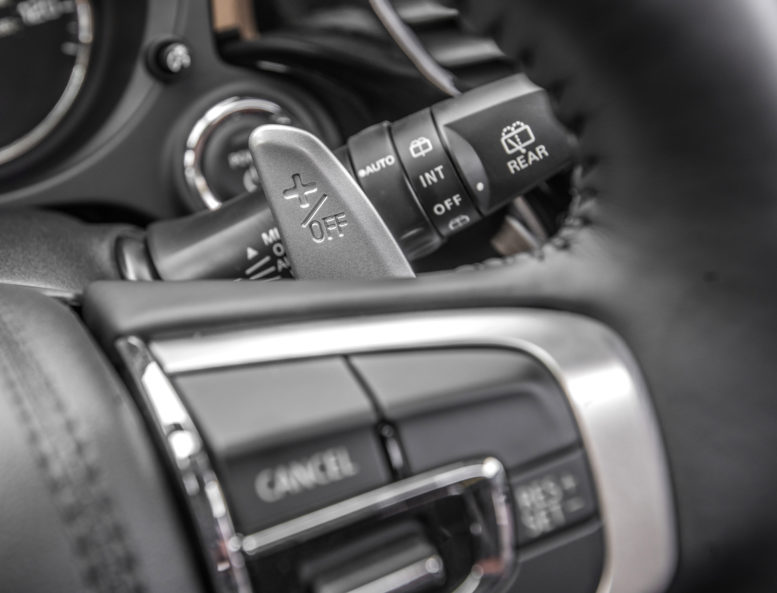
2016 Mitsubishi Outlander PHEV shift paddles are used for regeneration level setting.
In general, Mitsubishi Outlander PHEV is well equipped, including the smart key. But it’d be nice if the Outlander, for example, would offer one or two electronic driver assistance system more. A big plus are the LED headlights. They work well, without disturbing blue-violet edges, and perfectly illuminate the road. We miss the ability to manage some functions (primarily heating, ventilation and charging) using smart phone. In Mitsubishi Outlander PHEV this is only possible through the built-in wireless connection, which has proven to be a security hole, so it’s best to turn this feature off.
Spacious interior, attractive price
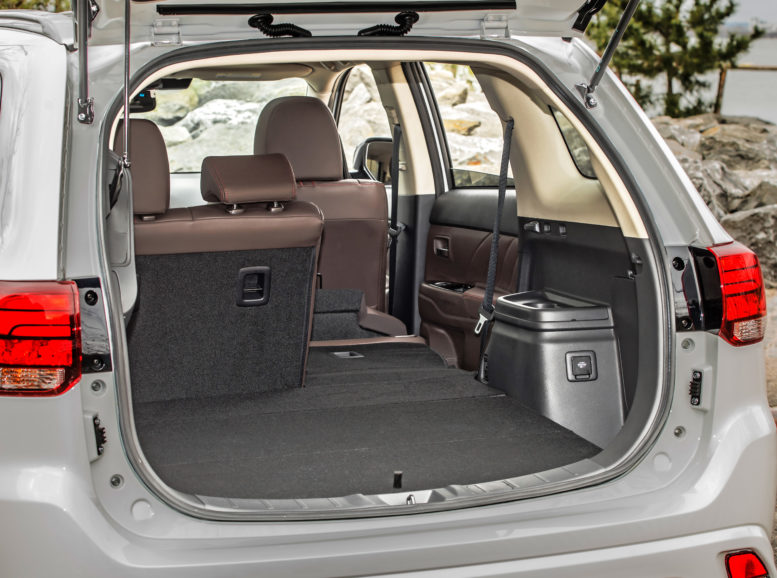
2016 Mitsubishi Outlander PHEV luggage compartment: 463-1602 l.
Mitsubishi Outlander PHEV 2016 is available only as a five-seater. The interior prides itself with sufficient spaciousness (including rear) and comfort, but above all, what makes this car interesting is its price. The amount you have to pay is very similar to that of similarly equipped (ie, four-wheel driven and with automatic transmission) diesel version. And because of that the sales success of a Mitsubishi Outlander PHEV is not as unexpected as it looks at first glance.
Mitsubishi Outlander PHEV technical specifications
Engine:
Petrol engine: 4-cylinder, 4 stroke, petrol, displacement 1998 cm3, maximum power 89 kW (119 hp) at 4,500 rev/min, maximum torque of 190 Nm at 4,500 rev/min.
Electric motor: maximum power of 60 kW + 60 kW, maximum torque of 137 Nm + 195 Nm.
Total system power: 149 kW (203 hp).
Battery: Li-Ion, 12.0 kWh.Transmission:
Engines power all four wheels.
Automatic transmission.Performance:
Top speed: 170 km/h (106 mph).
Acceleration 0-100 km/h: 11.0 s.Dimensions and weight:
Length: 4,695 mm.
Width: 1,800 mm.
Height: 1,710 mm.
Wheelbase: 2,670 mm.
Ground clearance: 190 mm.
Luggage compartment: 463-1602 l.
Fuel tank capacity: 45 l.
Empty vehicle weight (kerb weight): 1,845 kg.
Gross vehicle weight: 2,340 kg.
Tire size: 225/55 R 18.
Turning circle: 10,6 m.Fuel consumption and range:
Combined average fuel consumption (ECE): 1.8 l/100 km.
CO2 emissions: 42 g/km.
Electric range (ECE): 52 km.
Time charging the battery: 5 h (13 A), 3.5 h (16 A), 30 minutes (fast charging up to 80%).Electric range on test: 30-35 km.
Average fuel consumption on test: 4,1 l/100 km.Mitsubishi Outlander PHEV Price:
UK price: from around 32,000 pounds.
Germany price: from 39,990 EUR.
USA price: not confirmed yet, expected price from around 33,000 USD.
Image credit: Mitsubishi
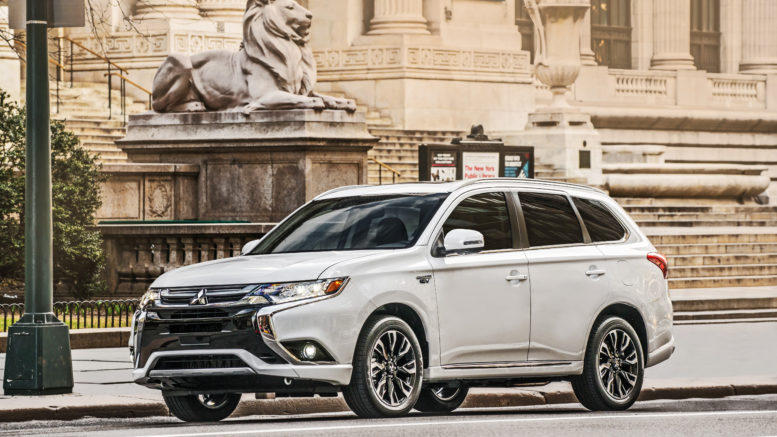

Be the first to comment on "Mitsubishi Outlander PHEV 2016 review – not unexpected sales success"